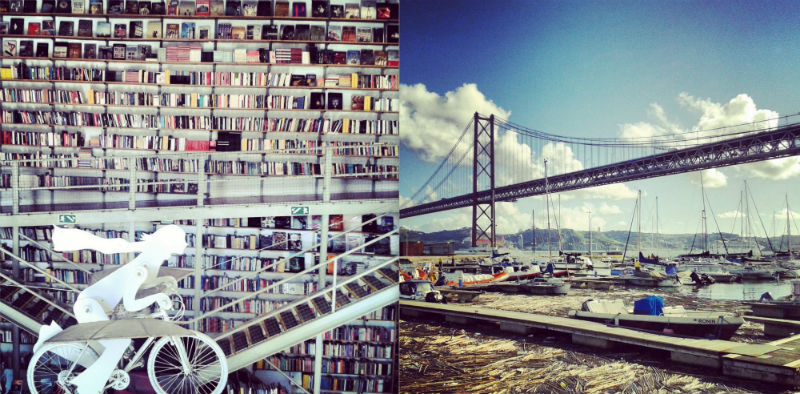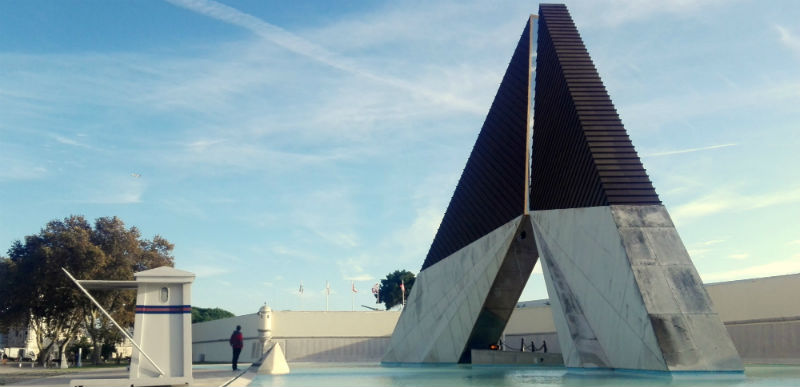Lisbon today is not as it was a decade ago, five, three or even one
A week ago I read one (not) short article by a Lithuanian guy about Lisbon and I thought to myself that he really doesn’t know what it means to discover this city. Either he is quite a negative person or maybe he just made very bad choices of the places that he could advise other travelers to visit. So I decided that I will write my tips about a few districts of Lisbon and around that you might consider visiting if you come here.
Last week we took a very nice afternoon walk around Belem. I love this area, because of the uncrowded open areas, the green spaces and the scale of the buildings and monuments. Most of the time I go there in the afternoons because it is less busy and the sunset at the Tejo riverside is astonishing. We were not like crazy tourists going around with a
LX Factory
You know if it happens that it is a bit rainy, like today, or you just want to experience something different you could start off a bit out of Belem – in Alcantara. Just under the Ponte 25 de Abril, the most famous bridge in Lisbon, there is a place called LX Factory. In the mid 19th century it was one of the most important manufacturing complexes in Lisbon and now it has been reborn as a creative island, home to exciting brands and startups in different fields like communication, politics, fashion, fine arts, and music. It is full of a dynamic atmosphere and great ideas, and in the middle of it all is the place where you can find the best chocolate cake in the world (according to me). There is also an amazing bookshop with coffee, snacks, Leonardo da Vinci’s flying ideas, crazy inventions, and music corners. Other interesting small shops, galleries, jeweler’s workshops, and restaurants sit side by side surrounded with a lot of cool graffiti and street art. It’s a great place to grab a snack, meet people, study, to come up with new ideas, relax or just hang around and maybe check out some events going on.
We like walks and to take a nice walk next to the river is always good. Nowadays from Alcantara to Belem Tower is a

Power Station – MAAT
Tejo Power Station was, guess what, a power
If you are interested in finding out more about the architecture of MAAT then check out this gallery: Archdaily – MAAT
Outside MAAT last week, we also ran into a little funny van – the Museum of Nothing, just a van with white space and empty shelves.

Monument of the Discoveries
Why do the Portuguese have this monument?
I wouldn’t even ask this question, just take a quick look back at the history of Portugal, with such well-known explorers and important historical moments. The 15th-16th centuries Age of Discovery, India, Vasco da Gama, Pedro Alvares Cabral. This monument is situated at the historical point on the river where ships departed for these journeys

Belem Tower
I love to look at this tower from the outside, it is so delicate and beautiful! You can also visit the inside if you feel like exploring the architecture, and sometimes nearby in summer time you can come and listen to live jazz in the open air or some other al fresco events.
Some stories tell that the tower was built on the river bed in the middle of the Tejo but actually there was originally it was a small island. Like most forts and towers on the shore, it was built to function as part of a
Jerónimus Monastery
I can’t really write a lot about it, because I have never been inside the monastery itself but only the church, I visited the church because it was always free entrance. The first important thing to mention is that this is one more example of the Portuguese late Gothic Manueline style architecture, and as you can probably guess if you have seen it, it is classified as a UNESCO World Heritage Site.
The Church of Santa Maria has two portals, the one we can see from
In the

Tropical Botanical Garden
Museums and culture are always nice, but I also love to be outside and enjoy the parks in big cities! Just on the other side of the road from
I don’t know a lot about plants, but I do know that here in the garden there are more than just the usual ones to discover. There are many species from tropical and subtropical regions, mostly in connection with former Portuguese discoveries and colonies. There are also some beautiful tile panels, marble sculptures, and a small ‘palace’. There is the possibility for guided tours, public lectures and special exhibitions.
After the crowds of the

Pasteis de Belem
For sure this was one of the points on my to-do list for my first time in Lisbon, but to be honest it is still on my list anytime I am in Belem. Why? I am not so sure!
Maybe I still believe that this is the best place to enjoy
Once you get to the end of the queue, how do you eat them? Of course with a good sprinkling of cinnamon and sugar powder! Are they vegan? NO! But you still can come and smell this secret recipe created before the 18th century. There are several stories about how the recipe is protected and that it is still kept a secret for most workers even inside this business.
So, what is a
Whether or not this is the best

There are, of course, many other places that I haven’t mentioned like the National Coach Museum, Military Museum, Belem Palace, The Navy Museum, and the Belem Cultural Center. Then there are boat tours, etc. but we always choose places according to our own interests and passions.

Lisbon is not just about Saint Jorge Castle, Alfama, Fado and good wine, there are so many things to do and to see! The easiest way to find them is just to make friends with some locals who will tell you many stories about their motherland and will show the best places in the city!
Or come and visit us we will certainly show the way how to become a local nonlocal 😀
What will be next? Not Alfama, not Faro, not Sintra or Cascais, next to discover is Marvila and Beato!


Thank you for the guide, sounds like some really nice places to visit when we are in Lisbon!
Glad you liked it Cathy and we hope you find it useful when you are in Lisbon, we’ve just posted another guide to Marvila & Beato which is another area that is definitely worth checking out. Have fun in Lisbon 😀